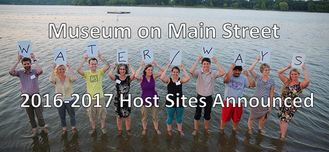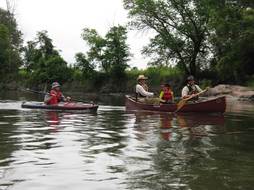|
March 2016
 The spring watershed networking and learning meeting is
scheduled for Thursday, April 21 at the Redwood Falls Pizza Ranch, 9:30
a.m.-2:30 p.m. We welcome your ideas for program topics. All organizations are welcome to bring copies of any new publications or other materials for a display table.
The program so far includes:
- "Quantifying hydrologic impacts of drainage under corn production
systems," – Jeff Strock, U of M research station, Lamberton
- "Fields to Streams-managing water in rural landscapes" – Ann Lewandowski, U of M Extension.
- Minnesota River updates: Congress, proposed legislation, TMDL status.
Any program updates will be announced later. This will be the 14th event since starting in 2009. Information about previous meetings is located on the watershed network web page: https://www.pca.state.mn.us/water/watershed-professionals-network. The
Pizza Ranch lunch buffet is $9.99. Further
details will be sent closer to the date. Hope
you can make it April 21.
Back to top
|
 The sixth Minnesota River Congress March 10 in New Ulm drew 78 people representing a wide variety of organizations devoted to the economic, natural, and social vitality of the Minnesota River basin. (Dana Melius-St. Peter Herald photo: Amy Lynch of rural Mapleton holds 16-month-old son, Stetson, at the Congress)
They heard interesting presentations about the river's fish population, and agricultural drainage management research, elected additional board members, and engaged in small group discussion in specific interest areas.
Anthony Sindt, a Minnesota
River fisheries specialist with DNR, gave a presentation on the fish populations
in the Minnesota River. Brian Hicks from rural Tracy gave a presentation on
innovative agricultural drainage management research at his farm.
Openings
still remain on the Action Board for two Native Americans, Dept. of Transportation, Minnesota River
Headwaters, Cottonwood and Pomme de Terre watersheds. New applicants will be
considered for those categories at the annual meeting in November. Congress participants were
then urged to distribute the Interest Network Survey to as many people as
possible and to use their contacts and any other means to get them to potential
interested people. The full meeting summary is available on the web at: www.watershedalliance.blogspot.com/
Back to top
|
A bill proposing to create a Minnesota River Commission reportedly has been withdrawn. Speaking at the Minnesota River Congress meeting March 10, Ron Harnack, representing the Lower Minnesota River Watershed District, said the bill has been shelved due to opposition among some counties and water management organizations in the basin. The bill (SF2204) calls for a commission to "coordinate with each of the 13 major watersheds... to complete... a plan of action" to achieve water quality and management goals.
Harnack said another bill may be introduced to develop and implement a Minnesota River basin plan for flow, sediment, and nutrient reduction. According to the bill, if a comprehensive plan is not completed by Dec. 31, 2020, or the 'one watershed one plan' is not developed in any of the 13 major watersheds, the counties in such watersheds "shall petition for the establishment of a watershed district." A bill number or sponsor has yet to be announced.
Back to top
 Six Minnesota communities have been selected by the Minnesota Humanities Center to host to Water/Ways, a new traveling exhibition and community engagement tool from the Smithsonian.
Minnesota is one of only five states chosen by the Smithsonian to launch this new traveling exhibit. The Minnesota tour includes visits to:
-
Prairie Woods Environmental Learning Center (New London-Spicer), June 25 – Aug. 7, 2016
-
Nicollet County Historical Society (St. Peter), Aug. 13 – Sept. 25, 2016
-
Goodhue County Historical Society (Red Wing), Oct. 1 – Nov. 13, 2016
-
Audubon Center of the North Woods (Sandstone), Nov. 19, 2016 – Jan. 1, 2017
-
Lanesboro Arts (Lanesboro), Jan. 7 – Feb. 19, 2017
-
Becker County Historical Society (Detroit Lakes), Feb. 25 – Apr. 9, 2017
Water/Ways reveals the central nature of water in our lives by exploring how Americans use water, how water unites communities, how water affects every element of life, and how Americans care for our water and protect this valuable resource for the future. More.
Back to top
|
Associated Press report Feb. 28: Fresh off his Governor's Water Summit, Gov. Mark Dayton says he now plans to hold a Water Action Week in April to build on the momentum. The summit drew more than 800 people to a downtown St. Paul hotel on Saturday to brainstorm on solutions to the state's critical water quality and supply issues.
Speaking to reporters afterward, Dayton said he plans to hold a Water Action Week sometime in April to get citizens more engaged on water issues. The governor says he hasn't decided exactly what that will entail, and still needs to digest the ideas generated during his water summit. But he says it's crucial for citizens to understand the water problems they face where they live, and know what they can do to be part of the solutions
Back to top
 The following is an abbreviated version of a comment submitted to the govenor's water summit by Don Reicosky, retired soil scientist at the ARS lab in Morris. Photo: Don speaking at the Chippewa River Watershed Project 2014 annual meeting.
Conservation agriculture evolved in North America following the
devastating erosion and social upheavals of the 1930s 'dust
bowls'. It started with simple, local innovations to
mitigate soil erosion, progressed through various stages of improved soil
management to no-tillage systems, then to conservation tillage systems,
resulting finally in the more comprehensive systems.
Conservation Agriculture is based on three key pillars: (1) continuous residue cover on the
soil surface; (2) continuous minimum soil disturbance (no-tillage); and (3)
diverse crop rotations and cover crop mixes. While these three main principles are general in their application, specific
differences in each principle need to be defined clearly to avoid confusion in
communication and use of terms.
The no-till system employed in Conservation Agriculture is not to be
confused with other forms of “conservation tillage” that substantially disturb
the soil surface. The success of the Conservation Agriculture system concepts rely on and benefit
from the interactive synergies between the biological, physical, and chemical
properties and processes in the soil that enhance Conservation Agriculture management. Conservation Agriculture resources-Cornell University
Back to top
|

Paddle river in a day still needs sponsors
The DNR is still looking for groups organize paddles in sections of the 'paddle the Minnesota River water trail in a day' event Saturday, June 11. The goal is to recruit as many paddlers as possible to cover every navigable mile of the 318 miles from the headwaters of Big Stone Lake near Ortonville to the confluence with the Mississippi River at Fort Snelling.
You can paddle alone, with your own group, or with an organized group. Information about organized groups, locations, and other details are available on the web page, or by contacting Alex Watson, alexander.watson@state.mn.us, 507-359-6062. By participating you can also chalk up miles for the DNR's "125 miles by bike, boot, or boat" challenge, celebrating 125 years of Minnesota state parks and trails.
Schottler on program at Chippewa annual meeting April 7
Dr. Shawn Schottler, of the St. Croix Watershed Research Station, will be the featured speaker at the Chippewa
River Watershed Project (CRWP) annual meeting on Thursday,
April 7, at the Starbuck Community Center. The evening begins with registration and social gathering at 5 p.m.,
meal at 6 p.m. and program at 7 p.m. The program will feature Dr. Schottler's presentation "Water Quality and Habitat Trends: Does the
future reflect the past?" and a panel of Chippewa River Watershed farmers.
A
panel of Chippewa River Watershed farmers who have been making operational and
landscape changes will share their experiences and perspectives on how their choices
are both profitable and more conducive to achieving water quality goals.
Everyone is invited. Meals are free with
pre-registration. Reservations are requested by Tuesday, April 5.
Call 320-269-2139 x120 or email jennifer.hoffman@chippewariver.org
to register.
CURE annual meeting April 23 in Morris
The 24th annual meeting of Clean Up the River Environment will be Saturday, April 23 at the West Central Research and Outreach Center in Morris. The business meeting will start promptly at 11 a.m. with a lunch to follow. After lunch, a roundtable discussion will begin. Doors open at 10 a.m. This year's annual meeting is scaled back due to work with multiple campaigns, and for saving resources to celebrate CURE's 25th anniversary next year.
Back to top
|
BWSR seeks board conservationist for New Ulm office
The Board of Water and Soil Resources is seeking to fill a Board Conservationist position in the New Ulm office. The position classification is State Program Administrator Principal. Current state employees can locate the position announcement by searching the Job ID 3946 on Employee Self Service - Click Here. All other applicants should apply through the MMB Careers website. http://mn.gov/mmb/careers/ .The requisition is open for all applicants through April 6, 2016. For more informatinon contact Jeff Nielsen at jeff.nielsen@state.mn.us. Click here to go to the MMB site - Job Announcement.
Warren named to water trails advisory committee
Natalie Warren has been appointed to the DNR Water Trails Citizen Advisory Committee. She recently took a relatively new job as the River Corridor Steward for the St. Croix River Association. Previously, Natalie was a co-founder of Wild River Academy. According to DNR Water Trails Coordinator Erik Wrede, the committee was formed in
2012 with three primary intentions: Develop a statewide
network of Water Trail user groups and build user group capacity; provide advocacy and
outreach for water recreation and stewardship; and promote best
management practices (BMPs) on Water Trails and at public water accesses.
Back to top
Three Minnehaha Creek Watershed District managers appointed
Lakeshore Weekly News, 3/17/16
Back to top
|